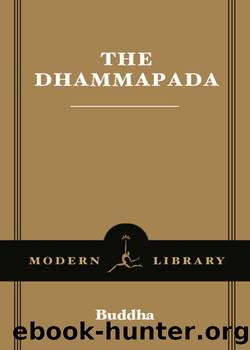The Dhammapada by Buddha

Author:Buddha
Language: eng
Format: epub
Tags: Fiction
ISBN: 9780307432148
Publisher: Random House Publishing Group
Published: 2007-12-18T00:00:00+00:00
CHAPTER THREE
MIND
The word translated as “mind” in this chapter is citta, the sense of personal identity and the “center” of lived experience. Citta is the human capacity to attend to things, to think, plan, scheme, be anxious, ponder, and long. This is a range of function that includes cognitive and affective, as well as reflective, qualities. For this reason, citta is often translated as “heart,” or even “heart-mind.” In light of the work that it does, citta seems to come closest to our colloquial use of “ego” (although the notion of the ahamkara, “I-maker,” might be a nearer equivalent).
In any case, the Buddha saw citta as the prime culprit in the pain of existence.
By what is the world led around? By what is it dragged here and there? What is the one thing that has all under its control?
The world is led around by mind [citta]. By mind it is led here and there. Mind is the one thing that has all under its control.
(Sam.yuttanikaya 1.1.205, 206)
So, if a person is to live a life of well-being, it is citta that must be calmed. The central theme of this chapter is therefore the restraint, taming, and guarding of the mind. To support the case for achieving this restraint, the chapter also indicates the nature of the mind, as well as the consequences of not taming the mind.
NOTES
33. mind. On citta, see note 13.
34. death. This is Mra. (See notes 7 and 37.)
35–36. ease. This is a translation of sukha, the analogue to dukkha (pain, unease). See the introduction to Chapter Fifteen.
37. bonds of Mara. (See also note 7.) In the story of the Buddha’s awakening, cobbled together from several canonical passages and elaborated on in the firstcentury C.E. poem by Avaghosa, Buddhacrita, “The Life of the Buddha,” Mra attempts to hinder the soon-to-be-Buddha (in some versions, this hindrance extends to the first moments of the awakening) in his quest for liberation. One way of understanding liberation is to see it as a release from the means through which Mra binds us: craving, discontent, and passion. Mra’s three daughters came to the Buddha to destroy his concentration and derail his endeavor. They came—
glittering with beauty—
Tanha, Arati, and Rga [Craving, Discontent, and Passion]—
But the teacher swept them away right there
as the wind, a fallen cotton tuft.
Download
This site does not store any files on its server. We only index and link to content provided by other sites. Please contact the content providers to delete copyright contents if any and email us, we'll remove relevant links or contents immediately.
The Way of Zen by Alan W. Watts(6292)
Ego Is the Enemy by Ryan Holiday(4963)
The Art of Happiness by The Dalai Lama(3851)
The Book of Joy by Dalai Lama(3708)
Why Buddhism is True by Robert Wright(3291)
Spark Joy by Marie Kondo(3090)
Shift into Freedom by Loch Kelly(3032)
Happiness by Matthieu Ricard(2890)
A Monk's Guide to a Clean House and Mind by Shoukei Matsumoto(2787)
The Lost Art of Good Conversation by Sakyong Mipham(2444)
The Meaning of the Library by unknow(2391)
The Third Eye by T. Lobsang Rampa(2174)
The Unfettered Mind: Writings from a Zen Master to a Master Swordsman by Takuan Soho(2160)
Red Shambhala by Andrei Znamenski(2074)
Anthology by T J(2049)
The Diamond Cutter by Geshe Michael Roach(1957)
Thoughts Without A Thinker: Psychotherapy from a Buddhist Perspective by Epstein Mark(1899)
Advice Not Given by Mark Epstein(1767)
Twilight of Idols and Anti-Christ by Friedrich Nietzsche(1764)
